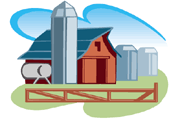Bulletin #2339, Maine Farm Safety Program: First Aid Kits for the Farm and Home

Bulletin #2339, Maine Farm Safety Program: First Aid Kits for the Farm and Home (PDF)
By Dawna L. Cyr, Farm Safety Project Assistant, and Steven B. Johnson, Ph.D., Extension Crops Specialist
For information about UMaine Extension programs and resources, visit extension.umaine.edu.
Find more of our publications and books at extension.umaine.edu/publications/.
Most people want to assemble or buy a first aid kit to place in the family car, shop or tractor, or in other places where it might be needed. First aid kits can be assembled from items found in the home or purchased in drug stores. Proper first aid training is more important than the best first aid kit. A person can help and treat people with knowledge, hands and nearby materials. A first aid kit is useless if a person does not know how to use it.
First Aid Kits
All trucks and buildings should have a first aid kit. The primary driver of each truck is responsible for ensuring that the kit is present and checked monthly for completeness. Any driver using the truck should make sure the kit is in the truck before taking it on a call. All buildings should have a 36-unit first aid cabinet, and it should be checked monthly.
Immediately replace any used component of the first aid kit. Replacement modules should be kept in inventory in each building. If any unused portion has a chance of being contaminated, it should be discarded and replaced. Keep all materials clean and sanitary.
- All vehicles and buildings should have a first aid kit.
- Restock supplies as they are used from the first aid kit.
First Aid Kits for Tractors and Other Farm Machinery
The following is a list of items that should be in a first aid kit carried in tractors and other farm machinery.
- A basic first aid manual
- Two triangular bandages with 36″ sides (made from bed sheets)
- Spray antiseptic (not a pressurized can)
- Sterile saline solution
- Twelve adhesive bandages and four safety pins
- Two pairs of rubber or latex gloves
- Eye goggles
- Three small packages of sugar
- Mouth protection device for mouth-to-mouth resuscitation
Dressing Supplies:
- Four compress bandages, 2″x2″, 4″x4″
- 24″x72″ compress
- One roll of adhesive tape
- Six pressure bandages
- Gauze bandage
- Stainless steel bandage scissors (strong enough to cut through denim)
- One elastic wrap
- Cold pack
- Amputation preservation kit (plastic bags: one large garbage bag, four kitchen-sized and two bread bags)
First Aid Kit for Home
Assemble a first aid kit for your home and one of each car. A first aid kit should include the following items.
- Sterile adhesive bandages in assorted sizes
- Two-inch sterile gauze pads (four to six)
- Four-inch sterile gauze pads (four to six)
- Hypoallergenic adhesive tape
- Triangular bandages (three)
- Two-inch sterile roller bandages (three roles)
- Three-inch sterile roller bandages (three roles)
- Splints: ¼ inch thick x 3 inches wide x 12 to 15 inches long
- Scissors, tweezers, needle
- Moistened towelettes
- Antiseptic
- Sterile saline solution
- Thermometer
- Tongue blades (two)
- Tube of petroleum jelly or other lubricant
- Assorted sizes of safety pins
- Cleansing agent/soap
- Latex gloves (two pair)
- Eye goggles
- Sunscreen
Non-prescription drugs such as:
- Aspirin or nonaspirin pain reliever (Remember: no aspirin for children!)
- Anti-diarrhea medication
- Antacid (for stomach upset)
- Laxative
- Activated charcoal (use if advised by the Poison Control Center)
This Maine Farm Safety fact sheet is part of an educational fact sheet series produced by University of Maine Cooperative Extension. For more information on farm safety, contact your UMaine Extension County Office.
Information in this publication is provided purely for educational purposes. No responsibility is assumed for any problems associated with the use of products or services mentioned. No endorsement of products or companies is intended, nor is criticism of unnamed products or companies implied.
© 2003, 2020
Call 800.287.0274 (in Maine), or 207.581.3188, for information on publications and program offerings from University of Maine Cooperative Extension, or visit extension.umaine.edu.
In complying with the letter and spirit of applicable laws and pursuing its own goals of diversity, the University of Maine System does not discriminate on the grounds of race, color, religion, sex, sexual orientation, transgender status, gender, gender identity or expression, ethnicity, national origin, citizenship status, familial status, ancestry, age, disability physical or mental, genetic information, or veterans or military status in employment, education, and all other programs and activities. The University provides reasonable accommodations to qualified individuals with disabilities upon request. The following person has been designated to handle inquiries regarding non-discrimination policies: Director of Equal Opportunity and Title IX Services, 5713 Chadbourne Hall, Room 412, University of Maine, Orono, ME 04469-5713, 207.581.1226, TTY 711 (Maine Relay System).

